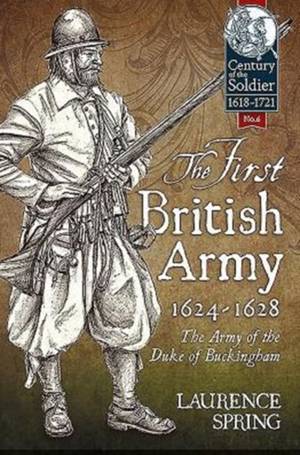
- Afhalen na 1 uur in een winkel met voorraad
- Gratis thuislevering in België vanaf € 30
- Ruim aanbod met 7 miljoen producten
- Afhalen na 1 uur in een winkel met voorraad
- Gratis thuislevering in België vanaf € 30
- Ruim aanbod met 7 miljoen producten
Zoeken
€ 34,95
+ 69 punten
Omschrijving
"A very well documented account...A real insight into just how difficult it could be to raise an effective army in those days."
-Miniature Wargames
True, the concept of Britain dates back to Roman times, but it was James I that founded Britain in the modern sense. With his accession to the throne in 1603 for the first time Scotland, England, Wales and Ireland were united - with James bestowing on himself the title of 'King of Great Britain'. Before this time, Scots and Irishmen may have served in the English Army as mercenaries, but it was known as an English Army - but now the King's (or British) flag flew over the castles and forts throughout the land. The army raised by Charles I in 1625 for his war against Spain -and subsequently, with France - is most famous for its failure. However, it is one of the best-documented armies of the early 17th century. Using archival and archaeological evidence, the first half of the book covers the lives of the officers and men serving in the army at this time - as well as the women who accompanied them. The author discusses the origins of officers and why they decided to serve in the army - and how the men from England, Scotland and Ireland were recruited (as well as how they were clothed and what they ate; the medical care; and the tactics used by the army at this time). It also covers the hidden faction of tailors, armorers and merchants who helped to put the army into the field. The second half of the book covers not only the expeditions to Cadiz, the Isle de Rhe and the siege of La Rochelle, but also their effect on an England who feared a Spanish (and later a French) invasion. Also covered are the campaigns of Count Ernest von Mansfeldt's and Sir Charles Morgan's armies at this time, which fought at Breda, Dessau Bridge and against the forces of the Holy Roman Empire. The final chapter looks at what became of the soldiers and their widows once the army had been disbanded - therefore, the book will be essential reading for anyone interested in Early Modern History, including the English Civil War and the Thirty Years War.
-Miniature Wargames
True, the concept of Britain dates back to Roman times, but it was James I that founded Britain in the modern sense. With his accession to the throne in 1603 for the first time Scotland, England, Wales and Ireland were united - with James bestowing on himself the title of 'King of Great Britain'. Before this time, Scots and Irishmen may have served in the English Army as mercenaries, but it was known as an English Army - but now the King's (or British) flag flew over the castles and forts throughout the land. The army raised by Charles I in 1625 for his war against Spain -and subsequently, with France - is most famous for its failure. However, it is one of the best-documented armies of the early 17th century. Using archival and archaeological evidence, the first half of the book covers the lives of the officers and men serving in the army at this time - as well as the women who accompanied them. The author discusses the origins of officers and why they decided to serve in the army - and how the men from England, Scotland and Ireland were recruited (as well as how they were clothed and what they ate; the medical care; and the tactics used by the army at this time). It also covers the hidden faction of tailors, armorers and merchants who helped to put the army into the field. The second half of the book covers not only the expeditions to Cadiz, the Isle de Rhe and the siege of La Rochelle, but also their effect on an England who feared a Spanish (and later a French) invasion. Also covered are the campaigns of Count Ernest von Mansfeldt's and Sir Charles Morgan's armies at this time, which fought at Breda, Dessau Bridge and against the forces of the Holy Roman Empire. The final chapter looks at what became of the soldiers and their widows once the army had been disbanded - therefore, the book will be essential reading for anyone interested in Early Modern History, including the English Civil War and the Thirty Years War.
Specificaties
Betrokkenen
- Auteur(s):
- Uitgeverij:
Inhoud
- Aantal bladzijden:
- 296
- Taal:
- Engels
- Reeks:
- Reeksnummer:
- nr. 6
Eigenschappen
- Productcode (EAN):
- 9781910777954
- Verschijningsdatum:
- 30/04/2016
- Uitvoering:
- Hardcover
- Formaat:
- Genaaid
- Afmetingen:
- 160 mm x 236 mm
- Gewicht:
- 793 g

Alleen bij Standaard Boekhandel
+ 69 punten op je klantenkaart van Standaard Boekhandel
Beoordelingen
We publiceren alleen reviews die voldoen aan de voorwaarden voor reviews. Bekijk onze voorwaarden voor reviews.











